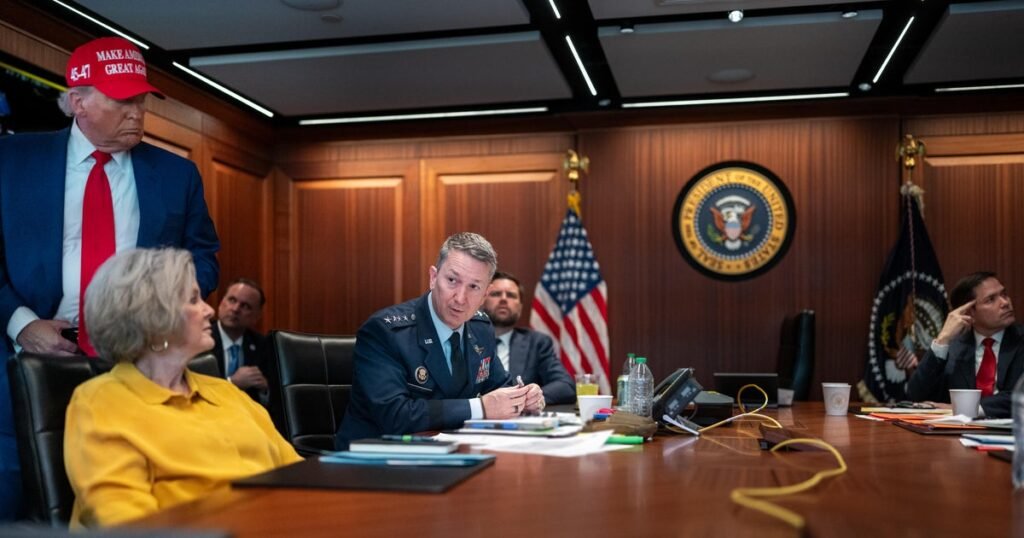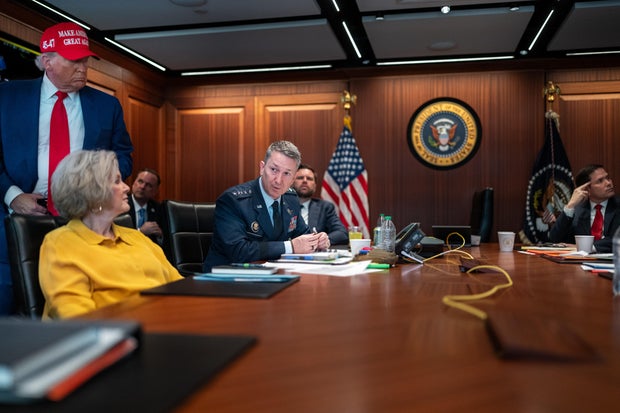Washington — On Saturday evening, President Trump revealed that the United States conducted military strikes on three Iranian nuclear sites, declaring it a “remarkable military achievement.”
“Our armed forces executed significant precision attacks on three crucial nuclear facilities in Iran: Fordo, Natanz, and Esfahan,” President Trump stated during a nationwide speech from the White House. “Our aim was to eradicate Iran’s nuclear enrichment capabilities and neutralize the nuclear threat from the world’s foremost state sponsor of terrorism.”
Before his speech, the president posted on his Truth Social platform that a “full payload of BOMBS” was unleashed on the “main site” Fordo and noted that all U.S. aircraft returned safely from Iranian airspace.
In a second post, Trump remarked: “This is a HISTORIC MOMENT FOR THE UNITED STATES OF AMERICA, ISRAEL, AND THE WORLD. IRAN MUST NOW AGREE TO END THIS WAR. THANK YOU!”
Trump cautions Iran against revenge after U.S. attacks
The president addressed the nation late Saturday, stating that “Iran’s primary nuclear enrichment facilities have been entirely obliterated,” while urging Iran to seek peace regarding its conflict with Israel.
“There will either be peace, or Iran will face tragedy far worse than what we’ve seen in the past eight days,” Mr. Trump said, flanked by Vice President JD Vance, Secretary of State Marco Rubio, and Defense Secretary Pete Hegseth. “Keep in mind, there are many targets remaining.”
He further stated that “if peace does not arrive swiftly, we will target those additional sites with speed, precision, and skill. Many can be neutralized within minutes.”
Iran has vowed to retaliate if the U.S. became involved in the Israeli strikes, which began with attacks on June 13. Iran has already retaliated with missile and drone strikes on Israeli cities.
However, following his national address, Trump warned that “ANY RETALIATION BY IRAN AGAINST THE UNITED STATES OF AMERICA WILL BE MET WITH FORCE FAR GREATER THAN WHAT WAS WITNESSED TONIGHT.”
Details on the U.S. strikes
Two senior Defense Department officials confirmed to CBS News that three B-2 bombers were deployed to hit Fordo early Sunday local time, each carrying two U.S.-made “bunker-buster” bombs known as GBU-57 Massive Ordnance Penetrators, or MOPs — bombs designed to be released solely by a B-2.
Fordo, the location of a crucial uranium enrichment site regarded by experts as vital to Iran’s nuclear ambitions, is situated nearly 300 feet beneath a mountain and secured by formidable air defenses. The MOP is perceived as the most effective method for demolishing the Fordo site.
The officials indicated to CBS News that Natanz and Isfahan were targeted by Tomahawk missiles shot from submarines, although it remains uncertain how many missiles were used against those two locations.
The U.S. contacted Iran diplomatically on Saturday to clarify that the airstrikes mark the extent of their military actions, with no plans for regime change. Earlier this week, various U.S. officials disclosed to CBS News that Mr. Trump rejected an Israeli strategy to eliminate Ayatollah Ali Khamenei, Iran’s supreme leader.
Not all U.S. allies in the region that host U.S. troops under U.S. Central Command were informed ahead of the U.S. strike plan, as per diplomatic sources. Some were alerted only as the aircraft were en route.
The United Nations’ International Atomic Energy Agency reported via social media that it confirmed “no increase in off-site radiation levels” following the U.S. attacks.
Responses from Israeli and Iranian officials
The U.S. notified Israel prior to the strikes, according to two White House officials speaking to CBS News. Following the attacks, Mr. Trump and Israeli Prime Minister Benjamin Netanyahu held a conversation. In a video statement, Netanyahu commended the president for executing the strikes.
“President Trump and I often emphasize peace through strength. Strength must come first, leading to peace. Tonight, President Trump and the United States displayed considerable strength,” he remarked.
According to the Iranian state media outlet IRNA, Morteza Heidari, a spokesperson for crisis management in Qom province, confirmed that all three nuclear facilities had been targeted. The Iranian Atomic Energy Organization also verified the strikes, claiming they would not hinder Iran’s progress in its nuclear initiatives, while urging the global community to denounce the attacks.
Additionally, in a social media update on Sunday morning, Iranian Foreign Minister Abbas Araghchi asserted that “in accordance with” the United Nations Charter “and its provisions, Iran reserves all options to defend its sovereignty, interests, and its people.”
Araghchi accused the U.S. of having “committed a serious violation of the UN Charter” in its military actions.
Officials are on alert for possible physical and cyber retaliation following the U.S. attack, with reports of a “very high” threat level. The recent events have crossed a critical point in the Iranian response strategy, according to CBS News.
“We’re in uncharted territory,” a U.S. intelligence official informed CBS News, referring to the possible Iranian threats against the U.S. homeland. “We can’t predict how Iran will respond, as this marks the highest level of tension and conflict in recent times. The reactions from the Khomeini regime are uncertain.”
The official noted that the possibilities range from minimal actions to severe and desperate measures from Iran.
Mixed Reactions from U.S. Lawmakers
House Speaker Mike Johnson received a briefing prior to the strikes, according to sources.
The responses from U.S. lawmakers have been varied. Some Republicans, including Johnson, voiced support for the military action, whereas others, like Rep. Marjorie Taylor Greene from Georgia, a strong Trump supporter, stated on X that “this is not our fight.”
Democratic leaders Hakeem Jeffries and Chuck Schumer criticized the president for not obtaining congressional approval for the strikes.
“President Trump deceived the nation about his intentions, neglected to seek congressional authorization for military action, and could lead America into a disastrous conflict in the Middle East,” Jeffries commented.
Senator Mark Warner, a Democrat from Virginia and vice chair of the Senate Select Committee on Intelligence, pointed out that Trump ran on a platform of ending continuous foreign wars.
“Tonight, he took steps that could entangle the U.S. in another, without consulting Congress, lacking a clear strategy, defying the consistent conclusions of intelligence assessments, and without informing the American public of the stakes involved,” Warner stated.
Background to the Unexpected Strikes
On Saturday, several U.S. officials confirmed to CBS News that B-2 bombers had taken off from Whiteman Air Force Base in Missouri, heading towards Guam. Numerous U.S. aerial refueling tankers were seen on flight trackers, following paths typical for escorting aircraft to the Pacific.
The U.S. strikes occurred after Iranian official Araghchi held discussions with European leaders in Geneva on Friday, expressing a willingness to engage in further dialogue.
“Iran is prepared to consider diplomacy again,” Araghchi stated, emphasizing that “Iran’s defense capabilities are non-negotiable. However, we are ready to meet again soon.”
On Thursday, the president indicated he would make a decision regarding the strikes within the next couple of weeks. A source told CBS News at that time that Trump believed there were few options left and that “finishing the job means destroying Fordo.”
U.S. Ambassador to Israel Mike Huckabee revealed earlier on Saturday that the U.S. had started evacuating American citizens and green card holders from Israel using assisted departure flights. Two flights departed from Tel Aviv to Athens carrying around 70 U.S. citizens, their family members, and lawful permanent residents, confirmed by the State Department before Trump announced the strikes.
Additionally, the White House shared images from the Situation Room during the strikes. Alongside the president were Vance, Hegseth, Senator Rubio, Joint Chiefs Chairman Dan Caine, CIA Director John Ratcliffe, Director of National Intelligence Tulsi Gabbard, Middle East special envoy Steve Witkoff, White House chief of staff Susie Wiles, deputy chief of staff Dan Scavino, deputy national security adviser Andy Baker, White House general counsel David Warrington, and press secretary Karoline Leavitt.
Gabbard’s involvement was noteworthy, especially as Trump had previously stated that she was “wrong” about Iran not pursuing nuclear weapons when she testified to Congress in March.
Hegseth and Caine were scheduled to provide updates on the operation during a news briefing at the Pentagon at 8 a.m. Eastern Time Sunday.





